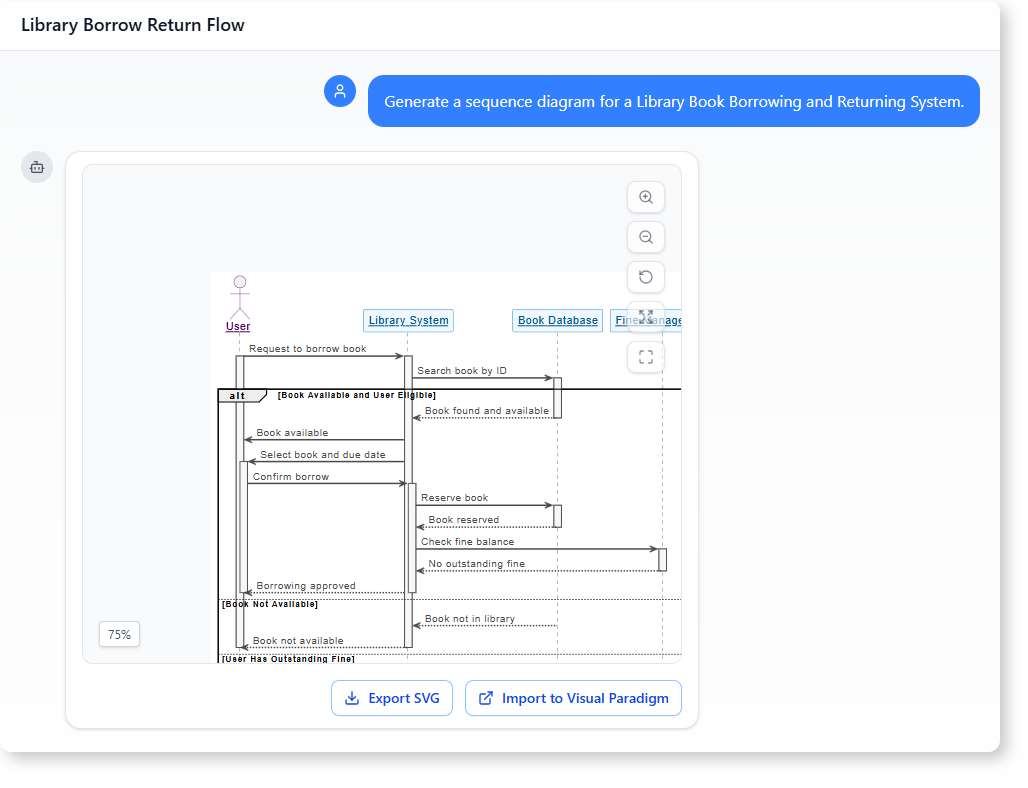Now Reading: How to Generate a Library Book Borrowing System Sequence Diagram with AI-Powered Modeling Software
-
01
How to Generate a Library Book Borrowing System Sequence Diagram with AI-Powered Modeling Software
How to Generate a Library Book Borrowing System Sequence Diagram with AI-Powered Modeling Software
How a Student Built a Library Book Borrowing System Using AI-Powered Modeling Software
Imagine you’re working on a school project about how a library manages book borrowing and returns. You need to show how users interact with the system, but you don’t have time to draw every step.
Instead of starting from scratch, you use an AI-powered modeling tool. You describe the process in plain language, and the tool creates a clear, professional sequence diagram—complete with logic for availability, fine checks, and eligibility.
This is exactly what happened when a student used Visual Paradigm’s AI-powered modeling software to build a Library Book Borrowing and Returning System.

What the Student Needed
The student was part of a software design class. They had to create a system model for a library’s book borrowing process. Their goal was to show:
- How a user borrows a book
- How the system checks availability and fine status
- How a user returns a book
- What happens in each scenario (book not available, user has outstanding fine)
They didn’t have access to UML tools or prior modeling experience. What they did have was a clear idea of the process and a need for something fast, accurate, and easy to understand.
Why This Process Needed AI-Powered Modeling
Traditional modeling tools require manual setup—dragging elements, drawing arrows, writing descriptions. That’s time-consuming and error-prone.
With AI-powered modeling software, the student could simply say:
“Generate a sequence diagram for a Library Book Borrowing and Returning System.”
And the software would interpret that, generate a correct UML sequence diagram, and structure it so it makes sense to a project report.
This approach saves time, reduces mistakes, and ensures the model reflects real-world logic.
Step-by-Step Journey with the AI Chatbot
The student started by opening the AI Chatbot in Visual Paradigm and typed:
“Generate a sequence diagram for a Library Book Borrowing and Returning System.”
The tool responded by creating a complete sequence diagram with all key participants: User, Library System, Book Database, and Fine Management.
The diagram clearly showed:
- The borrowing flow: user requests, system searches, book availability check, fine balance review, and approval
- The return flow: verification of return eligibility, fine check, and success confirmation
- Branch logic: what happens when the book isn’t available or the user has an outstanding fine
After reviewing the diagram, the student asked for a structured explanation:
“Create a structured explanation of this sequence diagram suitable for a project report.”
The AI responded with a clear, professional breakdown of the system’s behavior, including:
- Participant roles and responsibilities
- Flow control using conditional logic
- Real-world assumptions (like fine checks)
- How each step contributes to system integrity
The output was formatted like a report section, with headings, bullet points, and clear logic flow—perfect for a student to copy and submit.
What the Student Got
Instead of spending hours setting up the diagram manually, the student received:
- A fully accurate UML sequence diagram that captures all user interactions and edge cases
- A ready-to-use report-style explanation that can be directly included in a project document
- A model that reflects real-world logic, not just technical structure
The result was not just a diagram—it was a working system model that explained how the library system makes decisions in various scenarios.
This is the power of AI-powered modeling software. It doesn’t replace human judgment—it supports it by turning natural language into precise, visual representations of complex systems.
How This Works in Practice
Visual Paradigm’s AI-powered modeling software uses natural language understanding to interpret prompts and generate accurate models. Whether you’re modeling a Library System sequence diagram or a complex sequence diagram tool for any domain, the process is simple:
- Describe the system in plain terms
- Ask the AI to generate a diagram or report
- Review and refine as needed
No prior knowledge of UML or diagramming is required. You just explain what you want to model.
This makes it ideal for students, project teams, and anyone who needs to visualize system behavior quickly.
Is This the Future of Modeling?
Yes. The future belongs to tools that understand context and generate accurate models from simple prompts.
AI-powered modeling software like the one in Visual Paradigm is not just helpful—it’s essential for teams that need to model complex interactions quickly and clearly.
It reduces friction in design thinking and helps move from idea to model in minutes.
Frequently Asked Questions
Q: Can I generate a sequence diagram for a library system without knowing UML?
Yes. All you need is a clear description of how the system works. The AI interprets your words and builds the right model.
Q: Does the AI understand conditional logic like ‘if book not available’?
Yes. The AI recognizes branching logic in natural language and builds proper sequence diagrams with alt and else blocks.
Q: Can I use this to create a report for my project?
Absolutely. The AI creates structured explanations that can be copied directly into a project report.
Q: Is this tool useful for other systems?
Yes. It works with any system—like a payment process, order fulfillment, or inventory check—by understanding the interaction flow.
Ready to map out your system’s interactions? Give our AI-powered modeling software a try at Visual Paradigm’s AI Chatbot today!
